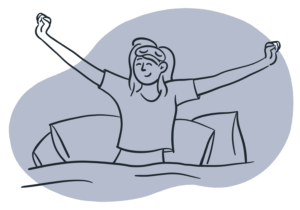Stages of Sleep
Disclosure: By clicking on the product links in this article, Mattress Nerd may receive a commission fee at no cost to you, the reader. Read full disclosure statement.
Ever wake up in the morning and feel like you barely slept at all? We’ve all been there. Many factors could contribute to this, but at the end of the day, it’s most likely that you just never got deep enough into the stages of sleep for your body and brain to recuperate.
Understanding Sleep Cycles
Don’t let the closed eyes and placid expression of someone sleeping fool you—plenty of activity is going on during those sleeping hours. Once we settle in beneath the covers, not only are there five distinct stages of sleep happening, but the stages repeat themselves throughout the night. Sleep is actually a very fascinating topic when you drill down into the details.
What makes each stage of sleep unique are the variations of brain wave frequencies, heart rate, blood pressure, muscle mobility, and breathing that characterize each specific phase we pass through. Between the time we hit the hay and, 7-8 hours later, then awakened by that alarm, our brain wave activity will have bounced back and forth from nearly no activity to intense activity repeatedly.
All of this sleep activity was virtually unknown prior to the 1950s, when sleeping and dreaming were simply a mystery. Up until then, sleep was thought to be nothing more than a quiet, unconscious rest period for bodies, and brain activity was thought to cease. All that changed in 1953 when scientists used electroencephalography (EEG) to measure brain waves during sleep. Through that technology, in addition to recording movement of the eyes and limbs, it was discovered that there were various stages of sleep involved.
The 5 Stages of Sleep
The complex sleep journey includes five distinct stages, four non-REM (rapid eye movement) stages, and the REM stage, each with a specific restorative role to play in maintaining our health and wellness. This explains why there is such emphasis on getting quality sleep, as it is essential to both our physical and mental health. Consider the sleep cycle as akin to a charging station, preparing us to be alert and high functioning for day ahead.
Sleep researchers use something called a hypnogram to record sleep activity. In charting the typical sleep pattern, as we traverse between the five stages of sleep each night, the resulting graphic, called sleep architecture, resembles a skyline. Peaks and valleys reveal the repetitive nature of sleep, and how long we might spend in each particular sleep stage. On average, each stage is experienced for about 90 minutes total each night, although a larger piece of the pie is spent in the second stage of sleep. The brainstem controls sleep architecture patterns, blood pressures, breathing, and heart rate.
- Stage One: This NREM stage features the lightest phase of sleep. We are drifting off, transitioning from wake to sleep, allowing our brains to shut down from conscious thought as our bodies begin to relax. As we fall sleep, breathing is still at a regular rate, eye movement is slow, rolling, and muscle tone is present. The sensation of falling and abrupt jerking movement called myoclonic jerk may occur. During this drowsy stage, EEG brain frequency is a bit slower, referred to as alpha waves, than during wake.
- Stage Two: During this stage, eye movement stops and slow waves, known as theta, ensue. Approximately half of our sleeping hours are spent, collectively, in this stage of sleep. Stage two features light sleep, with a slowing heart rate and lower body temperature. During this phase, muscle activity alternates between muscle tone and muscle relaxation. Occasional bursts of rapid brain activity known as sleep spindles will occur.
- Stages Three and Four: During these deep stages of sleep, awakenings rarely occur, and when arousing someone in this phase they will appear groggy and disoriented. Brain waves slow further, referred to as delta. During this phase, sleepwalking, nightmares, or other sleep disturbances may occur. There is no eye movement, breathing becomes deeper, slower, and noisier, and blood pressure drops further. This slow delta wave sleep is the most restorative phase of sleep, during which growth hormones replenish tissue and muscles.
- Stages Five: This is the unique rapid eye movement (REM) stage of sleep, during which the brain is extremely active and sharp, nearly as active as in the wake state. In fact, the EEG during the REM phase of sleep resembles that of someone who is wide-awake. The REM label is due to the rapid darting movements of the eyes in this phase of sleep. During REM sleep, the body is virtually paralyzed, heart rate and blood pressure rises, and breathing becomes shallower and more erratic. We spend about 20% of our sleep cycle in this REM stage. The REM stage is the phase that dreams occur, so when we are woken during this stage we tend to recall our dreams.
The sequence of the various stages of sleep occurs out of order once the first cycle of non-REM stages has occurred. This means that after the first pattern of stage 1, 2, 3 and 4 have been completed, a return to stage 2 happens before a short REM stage is entered. Following this, stage 2 is repeated again, with longer REM periods occurring, and so on. Sleep is certainly not boring.



